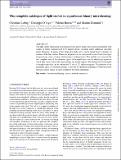The complete catalogue of light curves in equal-mass binary microlensing
Abstract
The light curves observed in microlensing events due to binary lenses span an extremely wide variety of forms, characterized by U-shaped caustic crossings and/or additional smoother peaks. However, all peaks of the binary-lens light curve can be traced back to features of caustics of the lens system. Moreover, all peaks can be categorized as one of only four types (cusp-grazing, cusp-crossing, fold-crossing or fold-grazing). This enables us to present the first complete map of the parameter space of the equal-mass case by identifying regions in which light curves feature the same number and nature of peaks. We find that the total number of morphologies that can be obtained is 73 out of 232 different regions. The partition of the parameter space so-obtained provides a new key to optimize modelling of observed events through a clever choice of initial conditions for fitting algorithms.
Citation
Liebig , C , D'Ago , G , Bozza , V & Dominik , M 2015 , ' The complete catalogue of light curves in equal-mass binary microlensing ' , Monthly Notices of the Royal Astronomical Society , vol. 450 , no. 2 , pp. 1565-1584 . https://doi.org/10.1093/mnras/stv733
Publication
Monthly Notices of the Royal Astronomical Society
Status
Peer reviewed
ISSN
0035-8711Type
Journal article
Description
This publication was supported by NPRP grant NPRP-09-476-1-78 from the Qatar National Research Fund (a member of Qatar Foundation).Collections
Items in the St Andrews Research Repository are protected by copyright, with all rights reserved, unless otherwise indicated.

